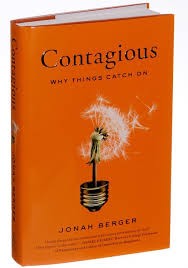Contagious: Why Things Catch On

Contagious is another one of those easy-to-read, useful, short books. It’s a good read for anyone who wants to spread their thoughts and ideas — be it product people, advertising folks aka mad men or even politicians. Jonah Berger provides a simple template to understand why things go viral — the STEPPS acronym sums it up:
Social Currency
Does talking about your product or message confer some social currency to the person talking about it? Does it make them seem a smart insider who has special access to something that’s hard to come by? Think of all the word of mouth Snapchat got in its initial days from its hidden features. Is your product remarkable enough that talking about it makes one look cool? Think of Will It Blend’s iPhone blending video.
Triggers
The more frequently people come across your product, or get triggered to think about it, the more viral it will be. A good reason for the virality behind Rebecca Black’s Friday video, besides everything else, was that Friday is a natural trigger. The graph from those days is actually quite beautiful:

Think about how you can trigger people to think about your product/idea more often. Can you bind it to a natural trigger that people encounter in their lives?
Emotion
We share when something arouses us — both in a good and in a bad way. Things that excite us, as well as things that infuriate us get more shares. This is also probably why most of the things we encounter on our Facebook feeds are so polarizing — nobody wants to read a rational bipartisan analysis of anything. If you want to make something go viral, focus on the strength of the feelings it will arouse, and not necessarily the function.
Public
The more publicly visible something is, the more likely it will grow by itself. Think of red bottom shoes and how you can create what Jonah Berger calls visible behavioral residue: Livestrong bracelets did this well.
Practical Value
While useful things get shared, you have to package them so that people can easily pass it on. My favorite idea from this chapter was the Rule of 100: a 25% discount on a $20 tee sounds better than an equivalent $5 off. However, a 25% discount on a $2000 laptop doesn’t as good as a $500 off the price. This is where the Rule of 100 comes in: use percentages for discounts unless the amount being saved is over a $100.
Stories
Humans have a tendency to fit everything into a story, and are constantly trying to pass them on to each other. We are social animals that love to communicate, and ideas get passed through idle chatter with stories as the vessels for these ideas. So construct a story that carries your idea along, and people would be more than happy to pass it on.
A sidenote: I once saw a tweet that mocked that you could probably get most of what a non-fiction book like this has to offer by reading just the table of contents. Not quite. Yes, you might think you have gotten the gist of the book by reading a small summary like this, or by glancing over the table of contents — but most non-fiction books are 5-10 main ideas accompanied by a score of examples elaborating each idea. The repetition, and the large number of applications of those ideas you see through those examples help you truly assimilate it to a point that it enters your subconscious. It takes a while for things to become second nature, for them to sink into your System 1, to become a part of your intuition. I highly recommend you to actually read these books and use these summaries only as a way to decide if this is something that piques your interest or not.
Happy Sunday!
This is #8 in a series of book reviews published weekly on this site.
